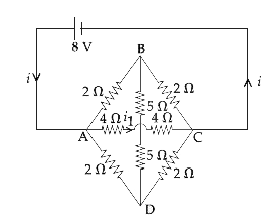Use kirchhoff's rules to determine the value of current I1 flowing in the circuit

1/5
21/5
31/5
41/5
The correct Answer is:c
Step by step video & text solution for Use kirchhoff's rules to determine the value of current I_(1) flowing in the circuit by Physics experts to help you in doubts & scoring excellent marks in Class 12 exams.
Updated on:21/07/2023Topper's Solved these Questions
- CURRENT ELECTRICITYBOOK - PRADEEPCHAPTER - CURRENT ELECTRICITYEXERCISE - Jee (main and advance)
4 Videos
- CURRENT ELECTRICITYBOOK - PRADEEPCHAPTER - CURRENT ELECTRICITYEXERCISE - Interger Type
2 Videos
- CURRENT ELECTRICITYBOOK - PRADEEPCHAPTER - CURRENT ELECTRICITYEXERCISE - Value based
2 Videos
- COMMUNICATION SYSTEMSBOOK - PRADEEPCHAPTER - COMMUNICATION SYSTEMSEXERCISE - MODEL TEST PAPER-2
9 Videos
- DUAL NATURE OF RADIATION AND MATTERBOOK - PRADEEPCHAPTER - DUAL NATURE OF RADIATION AND MATTEREXERCISE - Exercise
191 Videos
Similar Questions
A cylindrical copper conductor AB length L areaa of cross-section a has large number of free electrons which at mean temperature move at random within the body of the conductor like the molecules of a gas. The average thermal motion at room temperature is of the enter of 105ms−1 where a potential difference V is applied free electronic in the condictior experience , the free electrons in the conductor experience force and are accelerated towards the positive emf of the condutor on their gained kinetic energy After each collision the free electronic are angle acceleration due of the electric field , towards the positive end the conductor and next collision with the ions/atoms of the electrons The average speed of the free electrons with which they drift toward the positive and of the conductor under the effect of applied electric field is called drift of the electrons
When the potential difference is applied the two ends of the conductors , an electric field exists
View SolutionRefer .for what value of R (in ohm) will the current in galvanmeter G be zero
View SolutionAs is rubber and wood are insulatores there are no free electron or currecnt carrless to then .Therefore carrect can and not flow through then On the other hand human body and earth are good conductor A current of 10mA or more passing thought human body can be fated A current will flow only if the circuit is complete
Read the above passage and answer the following position:
(i) How can one repair on free line wires?
(ii) Why is a current of 10mA or more passage though human body fated?
(iii) What is the practical utility of this study?
View SolutionA galvanometer of resistance G is converted into a voltmenter to measrue upto V volts by connecting a resistance R1 in series with the coil. If a resistance R2 is connected series with it, then it can measure upto 1//2 volts. Find the resistance, in terms of R1 and R2, required to be connected to convert in into a voltmeter that can read upto 2V. Also find the resistance G of the galvanometer in terms of R1 and R2
View SolutionThe photoelectric effect can be explained on the basis of
View SolutionUse Kirchhoff's rules to determine the potential differnce between the poits A and D when no current flows in the arm BE of the electric network shown in figure
View SolutionApply kirchhoff's rules to the length PRSP and PRQP to wire the expression for the current I1,I2andI3 in the circuit

View SolutionUse kirchhoff's rules to determine the value of current I1 flowing in the circuit

View SolutionUsing kirchhoff's rules wire the experssion for the current I1,I2andI3 in the circuit diagram

View SolutionState Kirchhoff's rules . Apply Kirchhoff's rules to the loops ACBPA and ACBQA to write the expressions for the currents I_(1) , I_(2) and I_(3) in the network .
View Solutionकिरचॉफ के नियमों की सहायता से संलग्न चित्र में प्रदर्शित परिपथ में 5Ω के तार में प्रवाहित धारा के मान गणना कीजिये ।

View Solutionप्रदर्शित परिपथ में किरखॉफ़ के नियमों का उपयोग कर धारा I1,I2 व I3 के मान ज्ञात कीजिए।

View SolutionThe value of current i1 flowing from A to C in the circuit diagram is :

View SolutionUse Kirchhoff's rules to determine the potential difference between the points A and D when no current flows in the arm BE of the electric network shown in the Fig.

View SolutionUsing Kirchhoff's rules in the circuit shown determine (a) the voltage drop across the unknown resistor R, and (b) the current I in the arm EF.
View SolutionUsing Kirchhoff's rules determine the value of unknown resistance R in the circuit so that no current flows through 4 Ω resistance. Also find the potential difference between A and D.

View Solution
